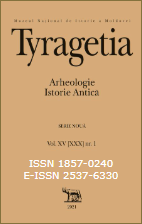Курган 16 группы «Bодовод» в Hижнем поднестровье
Barrow 16 of the “Sluiceway” group in the Lower Dniester region
Author(s): Vitalii S. Sinika, Nicolai P. Telnov, Sergey D. Lysenko, Sergey N. RazumovSubject(s): Archaeology, Social history, Cultural Anthropology / Ethnology, Prehistory
Published by: Muzeul Naţional de Istorie a Moldovei
Keywords: left bank of the Lower Dniester; Eneolithic; the second half of the 5th - the first half of the 4th millennium BC; Scythians; graves; sword of the Solokha type; amphorae; the third quarter of the 4th
Summary/Abstract: The article for the first time publishes and analyzes materials obtained during the study of the barrow 16 of the “Sluiceway” (“Vodovod”) group near the Glinoe village, Slobodzeya district, on the left bank of the Lower Dniester. The first mound, the main burial 12, and the accompanying grave 7 are dated preliminary to the Early or Middle Eneolithic on the basis of the handmade vessel fragments. The construction of the second mound is connected with two simultaneous Scythian burials, one of which belonged to the Scythian “aristocrats”. Later, eight Scythian graves were sunk into the barrow, covered with the third mound. They contained not only separate items testifying to the Thracian and La Tène influence on the material culture of the Scythians of the Lower Dniester region, but also made it possible to record a number of elements of the funerary rite used mainly in the process of children internment. The Scythian graves are dated to the third quarter of the 4th century BC on the basis of Heraclea and Sinope stamps.
Journal: Tyragetia (Serie Nouă)
- Issue Year: XV/2021
- Issue No: 1
- Page Range: 239-296
- Page Count: 58
- Language: Russian

